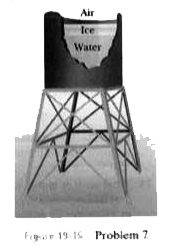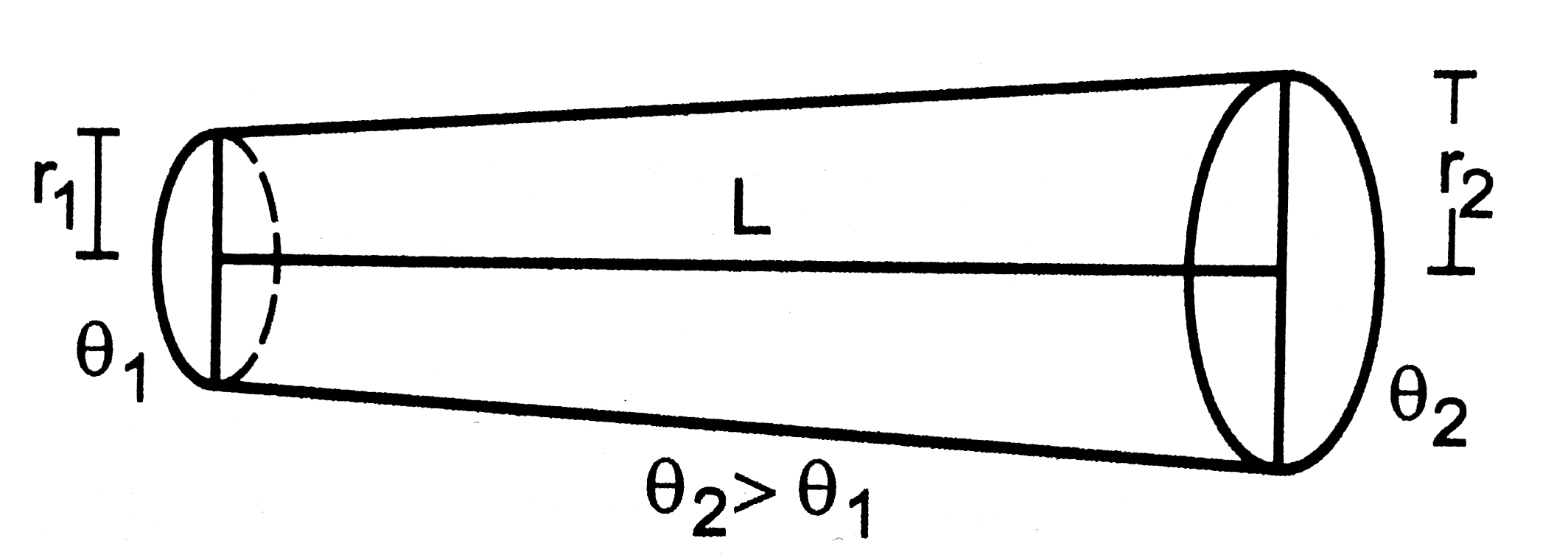PROBLEMS from RESNICK AND HALLIDAY PHYSICS (HINGLISH) HEAT-MEASUREMENT AND TRANSFER for Class 12
| Class 12 | PHYSICS |
| Chapter | HEAT-MEASUREMENT AND TRANSFER |
| RESNICK AND HALLIDAY PHYSICS (HINGLISH) | PROBLEMS |
| Medium | English |
| Academic Year | 2023-2024 |
Question 4
A certain substance has a mass per mole of 50.0 g/ mol. When 325 J is added as heat to a 30.0 g sample, the sample's temperature rises from 25.0∘ to 45.0∘ C. What are the (a) specific heat and (b) molar specific heat of this substance ? (c ) How many moles are in the sample ? View SolutionQuestion 5
One way to keep the contents of a garage from becoming too cold on a night when a severe subfreezing temperature is forecast is to put a tub of water subfreezing temperature is forecast is to put a tub of water in the garage. If the mass of the water is 135 kg and its initial temperature is 20∘C, (a) how much energy must the water transfer to its surrounding in order to freeze competely and (b) what is the lowest possible temperature of the water and its surrounding until that happens?View SolutionQuestion 7
A small electric immersion heater is used to heat 170g of water for a cup of instant coffee. The heater is labeled "180 watts" ( it converts electrical enery to thermal energy at this rate ). Calculate the time required to bring all this water from 23.0∘C to 100∘C, ignoring any heat losses.View SolutionQuestion 10
Leidenfrost effect. A water drop will last about 1 s on a hot skillet with a temperature between 100∘C and about 200∘0. However, if the skillet is much hotter, the drop can last several minutes, an effect named after an early investigator. The longer lifetime is due to the support of a thin layer of air and water vapor that separates the drop from the metal ( by distance L in Figure ) . Let L = 0.0800 mm, and assume that the drop is flate with height h = 1.50 mm and bottom face area A=5.00×10−6m2. Also assume that the skilled has a constant temperature Ts=300∘C and the drop has a temperature of 100∘C.Water has density ρ=1000kg/m3, and the supporting layer has thermal conductivity k=0.026W/m.K. (a) At what rate is energy conducted from the skillet to the drop through the drop's bottom surface? (b) If conduction is the primary way energy moves from the skilled to the drop, how long will the drop last ?
 View Solution
View SolutionQuestion 11
Ethyl alcohol has a boiling point of 78.0∘C, a freezing point of −114∘C, a heat of vaporization of 879 kJ /kg, a heat of fusion of 109kJ /kg , and a specific heat of 2.43 kJ /kg.K. How much energy must be removed from 0.720kg of ethyl alcohol that is initially a gas at 78.0∘C so that it becomes a solid at −114∘C ? View SolutionQuestion 12
Figure shows the cross section of a wall made of three layers. The layer thicknesses are L1,L2=0.750L1, and L3=0.350L1. The thermal conductivities are k1,k2=0.900k1, and k3=0.800k1. The temperature at the left side and right side of the wall are TH=30.0∘C and TC=−15.0∘C, respectively. Thermal conduction is steady . (a) What is the temperature difference ΔT2 across layer 2 ( between the left and right sides of the layer ) ? If k2 were, instead, equal to 1.1k1, (b) would the reate at which energy is conducted through the wall be greater than, less than, or the same as proviously, and (c ) what would be the value of ΔT2 ?
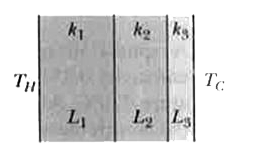 View Solution
View SolutionQuestion 15
Evaporative cooling of beverages. A cold beverage can be kept cold even on a warm day if it is slipped into a porous ceramic container that has been soaked in water. Assume that energy lost to evaporation matched the net energy gained via the radiation exchange through the top and side surfaces. The container and beverage have temperature T=10∘C, the environment has temperature Tenv=32∘C, and the container is a cylinder with radius r=2.2cm and height 10cm. Approximate the emissivity as ε=1, and neglect other energy exchanges .At what rate dm/ dt is the container losing water mass ? View SolutionQuestion 16
A solid cylinder of radius r1=2.5cm , length h1=5.5 cm, emissivity 0.85, and temperature 30∘C is suspended in an environment of temperature 50∘C. (a) What is the cylinder's net thermal radiation transfer rate P1 ? (b) If the cylinder is stretched until its radius is r2=0.50cm , its net thermal radiation transfer rate becomes P2. What is the ratio P2/P1 ? View SolutionQuestion 17
Figure shows ( in cross section ) a wall consisting of four layers, with thermal conductivities k1=0.060W/m.K,k3=0.040W/m.K, and k4=0.12W/m.K(k2 is not known). The layer thickness are L1=1.2cm,L3=5.6cm, and L4=4.0cm (L2 is not known ) . The known temperatures are T1=30∘C,T12=25∘C, and T4=−10∘C . Energy transfer through the wall is steady. What is interface temperature T34 ?
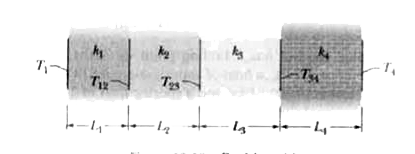 View Solution
View SolutionQuestion 19
If you were to walk brieftly in space without a spacesuit while far from the Sun ( as an astronaut does in the movie 2001, A Space Odyssey ), you would feel the cold of space- while you radiated energy, you would absorb almost non from your environment . (a) At what rate would you lose energy ? (b) How much energy would you lose in 44s ? Assume that your emissivity is 0.90, and estimate other data needed in the calculations.View SolutionQuestion 20
Ice has formed on a shallow pond, and a steady state has been reached, with the air above the ice at −5.0∘C and the bottom of the pond at 4.0∘C. If the total depth of ice + water is 2.0m, how thick is the ice ? (Assume that the thermal conductivity of ice and water are 0.40 and 0.12 cal/m.∘C.s, respectively. ) View SolutionQuestion 21
Penguin huddling.To withstand the harsh weather of the Antartic, emperor penguins huddle in groups ( Figure ). Assume that a penguins is a circular cylinder with a top surface area a = 0.26m2 ,and height h = 90 cm. Let Pr be the rate at which an individual penduin radiates energy to the environment (through the top and the sides ), thus NPr is the rate at which N identical, well separated penguins radiate. if the penduins radiate. If the penguis huddle closely to form a huddled cylinder with top surface area Na and height h, the cylinder radiates at the rate Ph. If N = 1000, (a) what is the value of the fraction Ph/NPr and (b) by what percentage does huddling reduces the total radiation loss ?
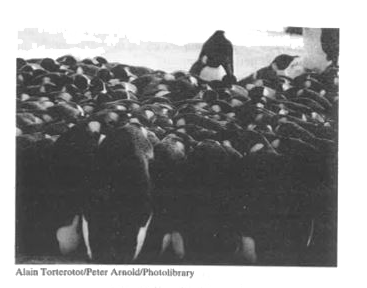 View Solution
View SolutionQuestion 22
The giant hornet Vespa mandarinia japonica preys on Japanes bees.However, if one of the hornets attempts to invade a beehive, several hundred of the bees quickly form a compact ball around the hornet to stop it. They do not sting, bits, crush , or suffocate it. Rather they overheat it by quickly raising their body temperatures from the normal 35∘C to 47∘ or 48∘C, which is lethal to the hornet but not to bees (Figure ). Assume the following : 500 bees from a ball of radius R = 1.8 cm for a time t = 18 min, the primary loss of energy by the ball is by thermal radiation, the ball's surface has emissivity ε=0.80, and the ball has a uniform temperature . On average, how much additional energy must each bee produce during the 18 min to maintain 47∘C ?
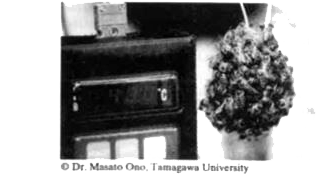 View Solution
View SolutionQuestion 24
What mass of butter, which has a usable energy content of 6.0KCal/g(=6000cal/g) , would be equivalent to the change in gravitational potential energy of a 78.0 kg man who ascends from sea level to the top of Mt. Everset, at elevation 8.84 km? Assume that the average g for the ascent is 9.80m/s2.View SolutionQuestion 25
(a) Two 40g ice cubes are droped into 200g of water in a thermally insulated container. If the water is initially at 25∘C, and the ice comes directly from a freezer at −15∘C, what is the final temperature at thermal equilibrium? (b) What is the final temperature if only one ice cube is used ? View SolutionQuestion 26
A 0.600kg sample is placed in a cooling apparatus that removes energy as heat at a constant rate. Figure gives the temperature T of the sample versus time t, the horizontal scale is set by ts=80.0 min. The sample freezes during the energy removal. The specific heat of the sample in its initial liquid phase is 3000J/kg.K. What are (a) the sample's heat of fusion and (b) its specific heat in the frozen phase ?
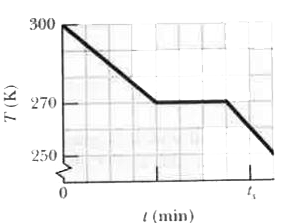 View Solution
View SolutionQuestion 27
A cylindrical copper rod of length 0.60m and cross-sectional area 6.0 cm2 is insulated along its side. The ends are held at a temperature difference of 100∘C by having one end in a water -ice mixture and the other in a mixture of boiling water and steam. At what reate (a) is energy conducted by the rod and (b) does the ice melt ? View SolutionQuestion 28
In a solar water heater, energy from the Sun is gathered by water that circulates through tubes in a rooftop collector. The solar radiation enters the collector through a transparent cover and warms the water in the tubes, this water is pumped into a holding tank. Assume that the efficiency of the overally system is 25% ( that is, 80% of the incident solar energy is lost from the system ). What collector area is necessary to raise the temperature of 200L of water in the tank from 20∘C to 40∘ in 1.0 h when the intensity of incident sunlight is 750 W/m2 ?View SolutionQuestion 29
A person makes a quantity of iced tea by mixing 250g of hot tea (essentially wwater ) with an equal mass of ice at its melting point.Assume the mixture has negligible energy exchange with its environment. If the tea's initial temperature is Ti=90∘C, when thermal equilibrium is reached what are (a) the mixture's temperature Tf and (b) the remaining mass mf of ice ? If Ti=70∘C, when thermal equilibrium is reached what are (c ) Tf and (d) mf ? View SolutionQuestion 30
A 150 g copper bowl contains 260 g of water, both at 20.0∘C A very hot 300 g copper cylinder is dropped into the water, causing the water to boil, with 5.00 g being converted to steam. The final temperature of the system is 100∘C. Neglect energy transfers with the environment. (a) How much energy ( in calories ) is transferred to the water as heat ? (b) How much to the bowl ? ( c ) What is the original temperature of the cylinder ? View SolutionQuestion 34
(a) Calculate the rate at which body heat is conducted through the clothing of a skier in a steady-state process, given the following data: the body surface area is 1.8m2, and the clothing is 1.0 cm thick , the skin surface temperature is 33∘C and the outer surface of the clothing is at 1.0∘C, the thermal conductivity of the clothing is 0.040W/m.K. (b) If , after a fall, the skier's clothes became soaked with water of thermal conductivity 0.60W/m.K, by how much is the rate of conduction multiplied ? View SolutionQuestion 37
A metal ball of mass 1kg is heated by means of a 20W heater in a room at 20∘C . The temperature of the ball becomes steady at 50∘C . (a) Find the rate of loss of heat to the surrounding when the ball is at 50∘C . (b) Assuming Newton's law of cooling, calculate the rate of loss of heat to the surrounding when the ball is at 30∘C . (c) Assume that the temperature of the ball rises uniformly from 20∘C to 30∘C in 5 minutes. Find the total loss of heat to the surrounding during this period. (d) Calculate the specific heat capacity of the metal.View Solution
All Exercises from RESNICK AND HALLIDAY PHYSICS (HINGLISH) Class 12 PHYSICS HEAT-MEASUREMENT AND TRANSFER
- CHECKPOINT 1
- CHECKPOINT 2
- CHECKPOINT 3
- PROBLEMS
- PRACTICE QUESTIONS
- PRACTICE QUESTIONS( INTEGER TYPE)
- PRACTICE QUESTIONS( LINKED COMPREHENSION)
- PRACTICE QUESTIONS(MORE THAN ONE CORRECT CHOICE TYPE )
- SOLVED PROBLEM 19.01
- SOLVED PROBLEM 19.02
- SOLVED PROBLEM 19.03
- SOLVED PROBLEM 19.04
- SOLVED PROBLEM 19.05
- SOLVED PROBLEM 19.06
- SOLVED PROBLEM 19.07
- SOLVED PROBLEM 19.08


